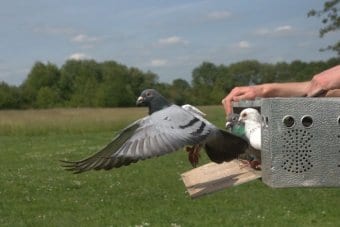
by Pigeon Patrol | Jun 14, 2023 | Bird Spike, Pigeon Predators, Pigeon Spikes, Pigeons, Pigeons in the News, Raccoons, Sparrows, UltraSonic Bird Control
A study on a population of pigeons on the University of South Africa’s Muckleneuk campus was conducted over 2 years. Counts were conducted during a baseline year (March 2013–February 2014) to establish the pigeon population index inhabiting the campus buildings, and again in the management year (August 2014–August 2015) once Eagle Eyes™, Fire (Flash) Flags, bird spikes and a combination thereof were implemented on the buildings. An efficacy reduction percentage was determined for each of the control structures. The total pigeon index on the campus declined by 50 % once the control structures were implemented. Control structures; however, differed markedly in efficacy from each other. Whilst bird spikes indicated the highest efficacy at reducing the pigeon population index, seasonality also influenced the efficacy of the control structure. Quantified understanding of the efficacy of pigeon control measures allows urban management to make informed decisions about reducing pigeon populations.
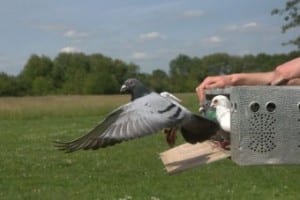
Source
Pigeon Patrol Products & Services is the leading manufacturer and distributor or bird deterrent (control) products in Canada. Pigeon Patrol products have solved pest bird problems in industrial, commercial, and residential settings since 2000, by using safe and humane bird
deterrents with only bird and animal friendly solutions. At Pigeon Patrol, we manufacture and offer a variety of bird deterrents, ranging from Ultra-flex Bird Spikes with UV protection, Bird Netting, 4-S Bird Gel and the best Ultrasonic and audible sound devices on the market today.
Voted Best Canadian wholesaler for Bird Deterrent products ten years in a row.
Contact us at 1 877-4-NO-BIRD,(604) 585-9279 or visit our website at www.pigeonpatrol.ca
Pigeon/Pigeon Patrol / Pigeons Roosing / Vancouver Pigeon Control / Bird Spikes / Bird Control / Bird Deterrent / PIgeon Deterrent / Surrey Pigeon Control / Pest / Seagull deterrent / Vancouver Pigeon Blog / Birds Inside Home / Pigeons in the cities / Ice Pigeons / What to do about pigeons / sparrows, Damage by Sparrows, How to Keep Raccoons Away, Why Are Raccoons Considered Pests / De-fence / Pigeon Nesting / Bird Droppings / Pigeon Dropping / woodpecker control / Professional Bird Control Company / Keep The Birds Away / Birds/rats/seagull/pigeon/woodpecker/dove/sparrow/pidgeon control/pidgeon problem/pidgeon control/flying rats/pigeon problems/ bird netting/bird gel/bird spray/bird nails/bird guard
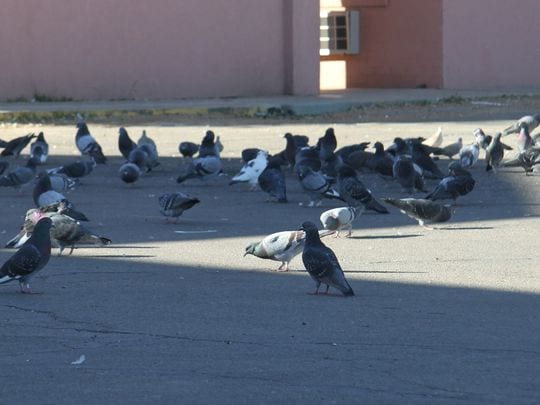
by Pigeon Patrol | Jun 14, 2023 | Bird Spike, Pigeon Predators, Pigeon Spikes, Pigeons, Pigeons in the News, Raccoons, Sparrows, UltraSonic Bird Control
Being a peregrine fanatic I’m kind of fond of pigeons – at least from the prey point of view – so when I was in downtown Pittsburgh on Sunday I stopped by Mellon Square to check out the scene.
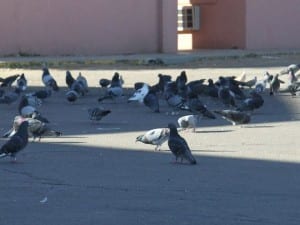
Even for a peregrine falcon the number of pigeons at Mellon Square is way too much of a good thing. I counted more than 150 and I couldn’t see all of them. The pigeons outnumbered people more than 30 to 1.
This explains why peregrines hang out on the Oliver Building window sills. It’s like visiting an all-you-can-eat restaurant. The food may not be that great but there’s so much of it!
This kind of pigeon over-population repulses most people and they want a quick fix, the quickest being poison. But if you poison a pigeon, you’ll poison a peregrine. After a culling episode pigeons reproduce fast to fill the void – in fact lethal control actually increases the flock – but the peregrines take years to recover. And peregrines are endangered in Pennsylvania. It’s bad, bad, bad to poison an endangered species.
So what to do?
Pigeons need two things to reach the numbers found at Mellon Square: lots of food and places to nest. They reproduce in direct proportion to their food supply. If food is scarce some won’t nest at all. If food is plentiful they lay the next clutch of eggs before the first set has hatched, producing more than 12 chicks per year.
The food problem is obvious. Sidewalks at Mellon Square are coated with bird seed. Control the food source (the people who feed them) and you’ve got most of the problem licked. To make a really dramatic difference, control the nest sites as well.
City pigeons nest on buildings and bridges. They also nest in buildings. Find the buildings involved and spend the time and money to block the access holes. Last summer the University of Pittsburgh cleaned the Cathedral of Learning and blocked off the pigeon nest holes as part of the cleaning job. One year later there are far fewer pigeons at Schenley Plaza.
And finally, there’s a foolproof solution that makes both the pigeon-feeders and the pigeon-haters happy. Many European cities have solved their pigeon problem permanently by building dovecotes and pigeon lofts. Yes, they built nest sites. They control the population at the dovecotes by substituting dummy eggs and they control the food level by giving pigeon lovers an approved place to feed and interact with the birds.
This keeps the pigeons and the birdseed off the street. An elegant solution.
Source
Pigeon Patrol Products & Services is the leading manufacturer and distributor or bird deterrent (control) products in Canada. Pigeon Patrol products have solved pest bird problems in industrial, commercial, and residential settings since 2000, by using safe and humane bird
deterrents with only bird and animal friendly solutions. At Pigeon Patrol, we manufacture and offer a variety of bird deterrents, ranging from Ultra-flex Bird Spikes with UV protection, Bird Netting, 4-S Bird Gel and the best Ultrasonic and audible sound devices on the market today.
Voted Best Canadian wholesaler for Bird Deterrent products ten years in a row.
Contact us at 1 877-4-NO-BIRD,(604) 585-9279 or visit our website at www.pigeonpatrol.ca
Pigeon/Pigeon Patrol / Pigeons Roosing / Vancouver Pigeon Control / Bird Spikes / Bird Control / Bird Deterrent / PIgeon Deterrent / Surrey Pigeon Control / Pest / Seagull deterrent / Vancouver Pigeon Blog / Birds Inside Home / Pigeons in the cities / Ice Pigeons / What to do about pigeons / sparrows, Damage by Sparrows, How to Keep Raccoons Away, Why Are Raccoons Considered Pests / De-fence / Pigeon Nesting / Bird Droppings / Pigeon Dropping / woodpecker control / Professional Bird Control Company / Keep The Birds Away / Birds/rats/seagull/pigeon/woodpecker/dove/sparrow/pidgeon control/pidgeon problem/pidgeon control/flying rats/pigeon problems/ bird netting/bird gel/bird spray/bird nails/bird guard
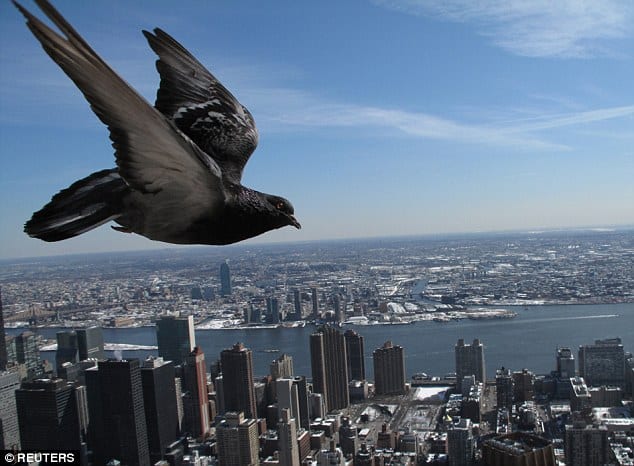
by Pigeon Patrol | Jun 14, 2023 | Bird Spike, Pigeon Droppings, Pigeon Patrol's Services, Pigeon Predators, Pigeon Spikes, Pigeons, Pigeons in the News
Rats with wings, or majestic streetwise bird? It’s a debate that’s raged almost as long as New York City has been called that. And this week, the war between the two sides boiled over again.
It started when the exclusive University Club had its feathers ruffled. It wanted to drape its storied building in netting, to protect it from pigeon poo, which eats away at stone and metal. But the Landmarks Commission said it would have to wait for approval, as it would be a “visible change” to the landmarked Italian Renaissance building’s façade. As if the crap wasn’t a “visible change” enough.
Meanwhile, over on East 93rd Street, there was a scuffle involving longtime pigeon activist Anna Dove and her neighbor, who snatched away her bag of seed after he saw her feeding the pigeons on the sidewalk. The police were summoned.
“It’s disgusting,” said her nemesis, retired teacher Arthur Schwartz. “She’s feeding the rats.”
And with the live pigeon-shooting state championships in Pennsylvania coming up, it’s almost guaranteed that there will be an increase in demand of pigeon-poaching — New York City is a favorite spot for trapping them and transporting them to be used as live targets. The animal-rights activists will be out with their cameras and signs to stop them.
No matter which side you’re on, one things for certain — by the end, things are going to get a little birdbrained.
*
“It’s not the pigeons that are the problem, it’s the number of them,” says Andrew D. Blechman, author of “Pigeons: The Fascinating Saga of the World’s Most Revered and Reviled Bird.” “They’re gentle creatures. The problem is that they get in our face, just like we get in each other’s faces.”
No one one’s quite sure of how many pigeons are in New York City. One adage is “one pigeon per person,” which would put their numbers at about 7 million. They each produce about 25 pounds of waste per year.
Pigeons love cities because of the many ledges, windowsills, eaves and rooftops available for them to roost in, which mimics their natural habitat of high cliffs. Pigeon pairings are monogamous, often mating for life, and both parents raise the babies — called squab — for a time, sitting on the eggs in shifts.
The pigeon includes about 298 species of bird, but the Rock Dove is the most common to the New York area, according to the Parks Department. The grey, bobbing-headed birds usually have purple-green iridescence around the neck area. They’re the scruffiest members of the dove family — although “dove” usually connotes the pure white symbols of peace, not the pizza scavengers of city streets. (Just say they’ve been pigeonholed.)
“If they were white,” Blechman says, “people would love them.”
Blame the French for our pigeon problems. The little pluckers first arrived in the early 1600s with French settlers who used them for meat. They were easy to raise — they could be kept in a barn, where they’d perch on the rafters, and young pigeons served as a good source of protein.
But they soon escaped their confines and went feral.
City life agreed with them and allowed them to flourish — and in some cases, over-flourish. Their natural predators, like falcons and hawks, aren’t found here in great numbers.
Courtney Humphries, author of “Superdove: How the Pigeon Took Manhattan . . . And the World,” concedes that pigeon are pilloried partly because of their “persistence. They nest on the buildings we consider our territory, and they don’t like to be moved.”
The average city pigeon has a lifespan of three to five years. With all the food scattered throughout the garbage cans and sidewalks — plus well-meaning human feeders — they spend less time looking for grub, which leaves more time for mating.
“The biggest problem is the people who overfeed them,” says Blechman. “Every city has about a dozen of them, and they’re the ones who cause the [overpopulation] problem.”
He suggests that if you want to feed the birds, hand out just a teaspoon full of birdseed for a flock. “It’s just enough to give them a little extra energy while they’re out trying to find their own food.”
“If nobody fed pigeons, I think things would look a lot different,” agrees Humphries, who says that human feeders end up creating dense flocks. “A lot of the problem with pigeons comes from people.”
If you can’t freeze the hearts of little old ladies, though, you could try eating them (the pigeons, that is). Squab — baby pigeons that haven’t flown yet — is on the menu at many restaurants around the city, particularly French. They’re “basically the milk-fed veal of the sky,” says Blechman — tender, mostly dark meat, and one of the only poultry that can be eaten rare. (Pigeons produce their own milk-like substance, which they feed to their young by regurgitation.)
Pigeon pot pie was a huge colonial favorite. Today, try the Squab and Foie Croustillant at the Modern, Danny Meyer’s restaurant at the Museum of Modern Art.
*
Unless the appetite for squab skyrockets, New York’s options are few. Avicide — poisoning birds — was made illegal in 2000, when the state Legislature passed a bill outlawing the use of “flock dispersal agents” like Avitrol in cities with more than 1 million people.
Before that, property managers regularly hired pest control services to dole out Avatrol to flocks of pigeons.
“In theory, you would mix it with feed, and when one pigeon ate some of the treated food, they would begin to suffer from neurological toxicity,” explained Stephanie Boyles, wildlife expert at the Humane Society of the United States. “When their flockmates saw them suffering, it would prompt them to leave the area.”
In practice, however, overdosing often led to large numbers of birds convulsing and writhing in pain on the street before their deaths. Welcome to New York!
The last major flare-up between pigeons and people was in 2007, when City Councilman Simcha Felder released a report plaintively titled, “Curbing the Pigeon Conundrum.”
Claiming that their droppings carried a host of diseases like histoplasmosis, he proposed a $1,000 fine to anyone feeding them, as well as curbing their numbers through birth control (a measure that cities like Los Angeles have adopted, although some argue that it’s unsustainable), and appointing a city “Pigeon Czar” to oversee other pigeon-control issues.
The NYC Department of of Health and Mental Hygiene maintains that contact with their droppings only poses a small health risk, and that “routine cleaning of droppings (e.g. from windowsills) does not pose a serious health risk to most people,” although disposable gloves are a good idea.
The Humane Society came out against the anti-feeding fine because they weren’t sure it would actually make a difference in reducing flocks, said Boyles. “We still suggest working with communities to create places where pigeons are welcome, and discouraging them where they’re not.”
While Felder’s bill didn’t fly, it was only one of many efforts to keep pigeons clipped.
In 2006, pigeon loitering was so dense near the Army Recruitment Center in Times Square, speakers were set up to broadcast sounds of falcons and pigeons being attacked, in hopes of scaring them away. In 2003, they had so overwhelmed Bryant Park that the operators invited a falconer and his hawk to the park for a week to scare away (not eat) the pigeons.
In 2007, the MTA installed Bird-B-Gone on some of its elevated stations along the 7 line, as well as others. The electronic system zapped birds that got too close.
In the ’80s, plastic owls were a big seller. Today, a slightly more high-tech version, called the RoboHawk, moves its head, wings, and makes what its creators hope are pigeon-threatening sounds.
Every so often, a politician considers reviving an overall anti-feeding bill, since, for now, it’s only illegal in city parks where signs are posted (the fine is usually $50).
Some cling to the hope that the city will come to its senses and declare war. Because they’re a non-native species, pigeons are not protected by either the Federal Migratory Birds Act or New York state laws. Can anyone say hunting season?
It’s got to be done mafia-style, though. Culling is only a temporary solution — as with most wild birds, quick breeding will put their numbers back to pre-cull figures within weeks, according to Pigeon Control Advisory Service.
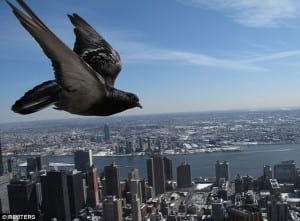
But spare a thought, pigeon haters, for your majestic foe. Pigeons have more qualities than you think.
Although city birds aren’t particularly active, pigeons are built to be athletes — a trained bird can fly up to 60 miles per hour, and they can stay in the air for 500 miles. They’re meant for flying long distances, and have “homing” instincts, which means they will naturally find their way back.
This talent is why they were literally drafted into the United States Army Pigeon Service.
A million served in both world wars, where they delivered messages across enemy lines and saved thousands of soldiers’ lives. One pigeon, Cher Ami, won a French medal for his bravery for flying through gunfire, finally delivering the message dangling from what was left of his foot. He’s now stuffed and in the Smithsonian.
The army’s Pigeon Breeding and Training Center was based at Fort Monmouth, NJ, and opened in 1917. Many of its “Pigeoneers” were “basically just boys out of Brooklyn, and they’d just bring their best birds,” Humphries says. (The training center was closed in 1957 when the Army stopped using them as messengers.)
Keeping pigeons on rooftops — and racing them — used to be much more popular. Who can forget Marlon Brando’s character in the 1954 film “On the Waterfront” shouting up to his friend Joey, “I got one of your birds!” right before Joey “accidentally” falls off the roof?
The city is full of equally vocal bird-lovers.
“They animate our lives,” argues Blechman, who says that despite writing a book on pigeons, he is not a “bird person,” and admits to having eaten them before. He’s come around, though. “You look out the window and you can have a pigeon land on your windowsill, and the same one will come back every day, and at the same time.
“What would the lonely, the unemployed, and the elderly do every day if it weren’t for pigeons?”
The Internet is atwitter with kooky pigeon fans. There’s a pigeon appreciation society on Facebook. On photo-sharing site Flickr, there’s a group called The Global Pigeon Art Appreciation Society.
“You are not alone,” the site reads. “Many artists have been inspired by pigeons.”
There is also a city listserv called “New York Pigeon People,” where members discuss how to rescue birds and share pigeon news.
You can eat them, race them, breed them, feed them, but you can’t escape them, whether you consider them the most misunderstood creatures of the flying community or the world’s worst bird. As Blechman put it, “We’re just going to have to learn to co-exist.”
Source
Pigeon Patrol Products & Services is the leading manufacturer and distributor or bird deterrent (control) products in Canada. Pigeon Patrol products have solved pest bird problems in industrial, commercial, and residential settings since 2000, by using safe and humane bird
deterrents with only bird and animal friendly solutions. At Pigeon Patrol, we manufacture and offer a variety of bird deterrents, ranging from Ultra-flex Bird Spikes with UV protection, Bird Netting, 4-S Bird Gel and the best Ultrasonic and audible sound devices on the market today.
Voted Best Canadian wholesaler for Bird Deterrent products ten years in a row.
Contact us at 1 877-4-NO-BIRD,(604) 585-9279 or visit our website at www.pigeonpatrol.ca
Pigeon/Pigeon Patrol / Pigeons Roosing / Vancouver Pigeon Control / Bird Spikes / Bird Control / Bird Deterrent / PIgeon Deterrent / Surrey Pigeon Control / Pest / Seagull deterrent / Vancouver Pigeon Blog / Birds Inside Home / Pigeons in the cities / Ice Pigeons / What to do about pigeons / sparrows, Damage by Sparrows, How to Keep Raccoons Away, Why Are Raccoons Considered Pests / De-fence / Pigeon Nesting / Bird Droppings / Pigeon Dropping / woodpecker control / Professional Bird Control Company / Keep The Birds Away / Birds/rats/seagull/pigeon/woodpecker/dove/sparrow/pidgeon control/pidgeon problem/pidgeon control/flying rats/pigeon problems/ bird netting/bird gel/bird spray/bird nails/bird guard
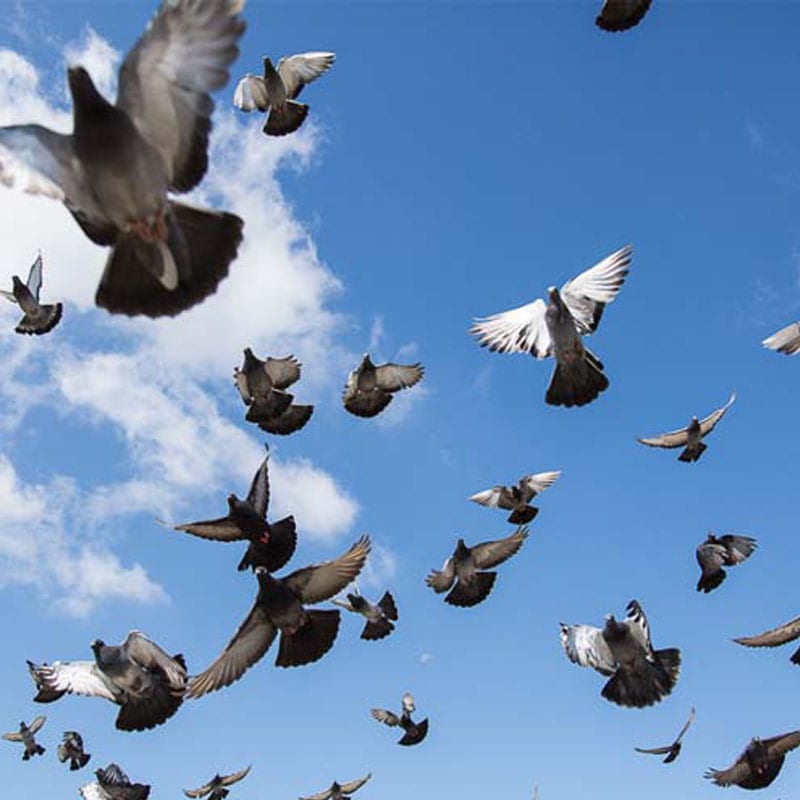
by Pigeon Patrol | Jun 14, 2023 | Bird Spike, Pigeon Droppings, Pigeon Patrol's Services, Pigeon Predators, Pigeon Spikes, Pigeons, Pigeons in the News
While pigeons are well known for living in cities, they’ll find their habitats anywhere. And whether you have an outdoor space that’s acres large or just a tiny balcony, you’ll likely receive visits from pigeons from time to time. A few pigeon coos or some droppings on your driveway may not be a huge concern. But if those harmless visits are turning into a constant nuisance, like excessive noise or cars coated in droppings, and you need to know how to deter pigeons, the steps below provide plenty of solutions to this problem.
So how do you get rid of pigeons? Start by eliminating any access to food sources, then follow up with deterrents that prevent them from landing or nesting near your home. It sounds simple, but if the problem of how to get rid of pigeons becomes too overwhelming, it may be best to call in the help of a professional from one of the best pest control companies that also offer wildlife control.
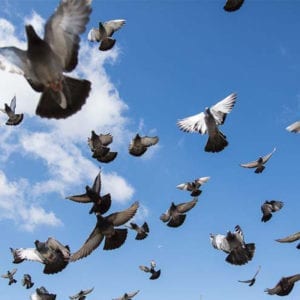
Before You Begin…
When wondering how to keep pigeons off your roof or how to keep pigeons off a balcony, it’s important to note that although they may seem harmless, pigeons can pose more of a problem than you may initially think. Pigeons are communal creatures, and large gatherings can cause excessive noise. Pigeon droppings are relatively acidic, and they can eat away at roofing materials and car paint if not removed. Plus, pigeon droppings can obscure a home’s solar panels, meaning that the solar panels can’t work as efficiently.
Droppings can also spread disease, and exposure to the birds could cause illness, especially in those who are immunocompromised. Pigeons themselves can carry a variety of parasites, such as ticks. If you have a significant pigeon problem, it may be worth contacting a professional who can use the proper tools and techniques to keep the birds away. It may even help to call an expert for advice before you invest time and money into various DIY methods—what may seem like a minor issue to you could be a larger-scale problem that definitely requires a pro’s help. Talking to a professional first can help you determine the full scope of the pigeon problem and what exactly will be needed to fix it.
Tips for Getting Rid of Pigeons
- Remove or secure any potential food sources, such as trash cans or compost receptacles.
- Apply bird spikes, netting, and reflective tape or shock strips, and set up a faux owl or hawk figure near the spot they frequent most.
Safety Considerations
- If the pigeons leave a significant number of droppings around the home, exposure could cause illness.
- Before attempting to trap or remove a pigeon from the inside of the home, it’s wise to contact an exterminator or animal control specialist first.
Source
Pigeon Patrol Products & Services is the leading manufacturer and distributor or bird deterrent (control) products in Canada. Pigeon Patrol products have solved pest bird problems in industrial, commercial, and residential settings since 2000, by using safe and humane bird
deterrents with only bird and animal friendly solutions. At Pigeon Patrol, we manufacture and offer a variety of bird deterrents, ranging from Ultra-flex Bird Spikes with UV protection, Bird Netting, 4-S Bird Gel and the best Ultrasonic and audible sound devices on the market today.
Voted Best Canadian wholesaler for Bird Deterrent products ten years in a row.
Contact us at 1 877-4-NO-BIRD,(604) 585-9279 or visit our website at www.pigeonpatrol.ca
Pigeon/Pigeon Patrol / Pigeons Roosing / Vancouver Pigeon Control / Bird Spikes / Bird Control / Bird Deterrent / PIgeon Deterrent / Surrey Pigeon Control / Pest / Seagull deterrent / Vancouver Pigeon Blog / Birds Inside Home / Pigeons in the cities / Ice Pigeons / What to do about pigeons / sparrows, Damage by Sparrows, How to Keep Raccoons Away, Why Are Raccoons Considered Pests / De-fence / Pigeon Nesting / Bird Droppings / Pigeon Dropping / woodpecker control / Professional Bird Control Company / Keep The Birds Away / Birds/rats/seagull/pigeon/woodpecker/dove/sparrow/pidgeon control/pidgeon problem/pidgeon control/flying rats/pigeon problems/ bird netting/bird gel/bird spray/bird nails/bird guard

by Pigeon Patrol | Jun 14, 2023 | Bird Spike, Pigeon Droppings, Pigeon Patrol's Services, Pigeon Predators, Pigeon Spikes, Pigeons, Pigeons in the News
At this time of year (February and March) many lofts will be experiencing respiratory infection in some of their young birds. This usually presents as a few birds with one eye becoming red and watery.
Respiratory diseases are common in pigeons. They are a major cause of poor performance and pigeon loss during the race season. Young birds under stress are most at risk of developing respiratory diseases, although healthy old birds can fall ill when exposed to respiratory diseases in the race basket. For birds to give of their best it is vital that fanciers have an understanding of respiratory infection and how to correctly manage it.

Nature of the disease
Clinical respiratory infection in pigeons is the end result of the interplay of a number of factors, but the type of infective organisms involved and the vulnerability of the birds to infection are particularly important.
The usual organisms involved are Mycoplasma, Chlamydia and a range of bacteria (most commonly, E. coli). Whether or not these organisms actually cause disease in a pigeon, if it is exposed, essentially depends on how well the pigeon is at the time of exposure and also its age and level of immunity. Any factors that cause physiological stress can weaken the bird and make it more vulnerable to developing a respiratory infection. As a general rule, younger pigeons are more susceptible. However, in a bird that is otherwise healthy exposure to the agents that cause respiratory infection does not necessarily make it sick. Exposure to these organisms as the young pigeons grow and develop, rather than cause disease, stimulates immunity to form in a bird that is otherwise healthy.
Predisposing stress factors that can make pigeons more vulnerable to respiratory infection can take the form of:
1. Environmental triggers; e.g. dampness, overcrowding, low hygiene
2. Management triggers; e.g. poor feeding, excessive tossing, or
3. Concurrent disease, in particular parasitism. This includes wet canker. The combination of either worms or elevated trichomonad levels and respiratory disease is very common.
The fancier must establish a healthy loft environment; otherwise respiratory disease will continually recur, despite medication. A good example here is a fancier who was recently in our clinic. He had a group of young birds that had dropped about three flights; that is, were about ten weeks old. A few kept getting ‘eye colds’. He would treat them and they would become well but within two weeks there would be more birds with the same problem. In a 2m x 2m section, he had 40 youngsters, and the humidity reading (from a hygrometer placed on the wall of the loft overnight) was 85%. Reducing the number of birds to 25 per section, and installing an additional vent high on the back wall improved ventilation and reduced humidity. The birds were again treated, but this time the problem did not return.
This article discusses respiratory infection associated with Chlamydia.
Chlamydia
Chlamydia are one of the 2 common organisms that cause respiratory infections in pigeons. Chlamydia are an unusual group of organisms. They are what are called intracellular bacteria , ie they actually live inside the tissues of animals. Being bacteria they are antibiotic responsive. As a group, they can cause disease in a variety of animals. One species causes disease in koalas while another causes a venereal disease in humans. The species that infects pigeons is called Chlamydia psittaci. It essentially has two lifecycle stages – a reticulate body and an elementary body. The elementary body can survive in the environment. Pigeons become infected through contact with the elementary body. The elementary body typically attaches itself to the superficial lining cells of the eyelid, throat or upper respiratory tract. The elementary body then penetrates the cell membrane into the cell and becomes a reticulate body. The reticulate body then replicates itself until there are many reticulate bodies in the cell. As the reticulate bodies increase in number, they rupture into adjacent cells causing cell destruction and an advancing wall of inflammation. Alternatively, they rupture back out on to the surface of the cell, once again becoming elementary bodies and further contaminating the environment. Infected birds with active disease shed large numbers of these infective elementary bodies in their saliva, tears, respiratory discharges and droppings contaminating the loft. Poor loft hygiene enables a build-up of the organism in the loft. Combine this with birds that are a bit run-down and a disease outbreak occurs. However in well managed lofts disease is rare. In fact ,as mentioned above, it is thought that low grade exposure to these Chlamydia elementary bodies may not cause disease but, rather, trigger the development of an immune response in a pigeon that enables it to be more resistant to the disease. The typical situation in most racing lofts is that Chlamydia tends to cycle through the birds. Growing youngsters are passively exposed to the organism from other birds in the loft and their parents. Often this doesn’t cause disease. Most birds, by the time they are six months old, have had multiple low grade exposures and have developed a significant immunity. Disease occurs if the youngsters become ‘run down’ due to stress factors and are therefore unable to mount an immune response or, alternatively, their level of immunity is challenged by a particularly high exposure to the organism. An antibiotic called doxycycline is very effective at treating Chlamydia. If a pigeon is given a 45-day course it has a 98% chance of clearing Chlamydia totally from its system. One would think that it would make sense to treat all the birds for 45 days, eradicating the disease and then not worry about it in the future. The difficulty with this is that if we were to eradicate Chlamydia, it is known that any immunity that the pigeons have would gradually disappear. This would mean that if the birds were subsequently re-exposed, they would be a very vulnerable population and potentially severe disease could occur. Once racing starts, exposure to Chlamydia in the race units is virtually guaranteed. Although drugs can be used to treat Chlamydia again and again if it keeps reappearing in returning race birds this is obviously not desirable. The factor that principally protects the birds in the race unit is the immunity that they are able to form if they are well cared for in the loft while young and maturing . Chlamydia is therefore managed by caring for the birds well ( so that they can mount a good immune response), by allowing a controlled exposure to the disease ( to build up a strong immunity) through the maintenance of loft hygiene and by using medication if required during development in a way that keeps the birds healthy but still allows some exposure to the disease. How is this done?
Post-weaning management
In the post-weaning time Chlamydia cycles through the developing young birds. Some youngsters may have passive immunity acquired through the egg and from their parents in the crop milk. Further exposure in the young bird loft builds on this immunity. Some youngsters take longer to form a protective immunity than others, and these can show symptoms of clinical Chlamydia infection. If the birds are well otherwise, these symptoms are often described as a “one eye cold”. Symptoms are often mild and may include a dirty cere, sneezing, nasal discharge, a partially closed light sensitive eye, inflamed red eyelids, and also tears overflowing the eyelids and becoming air dried on the feathers around the eye. If the number of birds affected is low and the symptoms are mild, often no treatment is provided. With ongoing good care it is likely that the birds will fix themselves and will develop a stronger natural immunity this way. If the symptoms in an individual bird become more severe, particularly if the bird’s development is starting to be compromised, treatment should be provided. The usual treatment is doxycycline 10–25mg per pigeon once daily. If less than 5–10% of birds are affected, it is best to just treat these birds individually. There is no need to separate them from the rest as all birds are likely to have the organism in them. Also young birds tend to recover better if left with the flock in a familiar loft. If more than 10% of birds develop symptoms then a flock treatment should be given. The usual treatment is doxycycline in the water. However, if 10% or more are developing symptoms, this tells you that this group of young pigeons is having trouble developing their natural immunity. And if they are having trouble developing a natural immunity this means that something is stressing them. A review of their management, loft environment and a check for any other (particularly Circo virus and parasitic) disease should be done. In young birds the underlying stress is often overcrowding. In Victoria, Australia, January to May are the respiratory months. Most lofts contain large numbers of young birds having just had the stress of weaning and now having the stress of moulting, coupled with young bird training and establishing themselves in the loft. It is a time of high humidity and fluctuating temperature, conditions that favour respiratory disease. Between 1 December and 1 March (the usual time that the last youngsters are weaned in many lofts in Australia), fanciers must monitor the youngsters, in particular for signs of “one-eye cold”, dirty wattles or sneezing. However, green watery droppings, failure to thrive, shortness of breath and a reluctance to fly may also be indicative of the problem. After 1 March in Australia, as the youngsters get older, fanciers look for signs of poor loft flying, excessive panting after training, and sneezing within the loft. Even in the healthiest lofts, there can be occasional outbreaks of respiratory diseases. It is important to recognise that more than three sneezes within five minutes from 100 birds is a significant indicator of early respiratory disease. One would expect two to three sneezing outbreaks between January and May, even in the best managed loft.
Pre-race management
As racing approaches, the birds have been given as long as possible to develop their natural immunity. It is important, however, that there is no active Chlamydial respiratory infection in the birds when racing starts. The can lead to poor race results and potentially disastrous returns. Chlamydia tests can be done by your veterinarian to see if the disease is still active and if the birds have formed a good immunity. The usual tests available are the Chlamydia immunocomb test, or Chlamydia PCR test.
A team should only be treated for Chlamydial respiratory infection before racing if it fits into one of the following categories:
1. If testing shows that the disease is still active in the birds, even if they look normal.
2. If Chlamydial respiratory infection was a problem during the early part of the racing season the previous year and the loft parameters have not changed (i.e. same loft design, same genetics, etc.)
3. If there was a significant amount of respiratory disease in the post-weaning time.
4. If the birds have a current clinical respiratory infection.
If the loft fits into one of the above categories then it is usual to treat the birds for 7–20 days with doxycycline, finishing two to three weeks before racing starts. Just how long an individual team is treated depends on the severity of the problem and the response to treatment. If they do not fulfil one of these criteria then no treatment is required.
I have had several fanciers tell me that they have been advised by a vet that the best thing to do prior to racing is treat their birds regardless with doxycycline. They were told that if it makes their birds sick then they don’t need it. If it does not make them sick then they must have Chlamydia and a long course of the drug should be given. I find this advice hard to believe as coming from a vet . It would see potentially tens of thousands of pigeons given antibiotics they don’t need in an absolute bogus way of assessing Chlamydia status. Such a suggestion is nonsense.
Management during racing
Ongoing exposure to Chlamydia occurs during the racing season. The natural immunity the birds have formed through development should be high enough to protect them; however, because of the stress associated with racing and potentially high exposure to the organism it may not be. Fanciers should monitor their birds closely for symptoms and have their birds regularly checked by an avian vet. If the birds become unwell or race performance is compromised due to Chlamydia, then the team is treated as a single unit and a flock treatment of doxycycline is given. Birds return to health fairly quickly, but not to race form. Sometimes a race needs to be missed and then the level of work gradually increased as the birds regain their health and fitness. If Chlamydia is diagnosed through the racing season, what should the fancier do?
1. Conduct a health profile– i.e. examination of the saliva and droppings and sometimes other tests as suggested by your veterinarian to assess any concurrent disease that may need treatment. Provide general ongoing good care to ensure a good response to medication.
2. Return to exercise gradually. Always, with respiratory infection, there is an extended convalescence usually of 1–3 weeks. The birds must be given time to recover their fitness once medication has cleared the infection. They should not be forced to fly around the loft and once it is apparent that their vigour for flying has returned, short tosses only should be given (less than ½ – 1 hour) initially. Observe the birds closely for signs of breathlessness on landing from these tosses and only when they are handling these well should longer tosses be given. When managing tosses of 1–1½ hours well, it is usually safe to resume racing. In well-managed lofts with no other health problems, response to treatment can, however, be dramatic and I have had an interesting experience where two fliers both diagnosed with respiratory infection in their teams succeeded in gaining 1st and 2nd Federation (3000 birds) in an all-day 800km race 3 weeks after treatment.
3. Give good food, good care and an appropriate multivitamin supplement to speed recovery.
4. Give appropriate medication. The choice of drug is often dependent on the involvement of secondary organisms, but usually the antibiotics doxycycline and tylosin are given together, or a blend of doxycycline, tylosin and spiramycin. An initial course usually of 3–10 days is given, depending on the severity of the infection and response to treatment.
Symptoms of Chlamydial Respiratory Infection
In young birds, symptoms are usually confined to the upper respiratory tract and the most common signs observed are a dirty cere, nasal discharge and a red watery eye. In some birds, however, the organism can infect various internal organs including the liver and spleen and also deeper parts of the respiratory tract, particularly the air sacs. These birds may just be quiet, be reluctant to fly, lose weight and develop a green mucoid dropping. Birds with inflamed air sacs often become breathless after moderate exercise and are sometimes forced to land wherever they are. This may include buildings or trees near the loft. By the start of racing the birds are older, their natural immunity is higher and their response to disease is different. The signs observed are modified by these factors and are often very subtle. Older birds with respiratory infection have lost their zest for life, and this is reflected in their race results. Birds that are reluctant to fly, quiet in the loft and with dry feathers (no bloom) are suggestive of respiratory infection. Irritation to the upper airway usually shows itself as an increased rate of sneezing. Sneezing (more than three times in five minutes from 100 birds), scratching at the nose, yawning, repeated exaggerated swallowing, stretching the neck and wiping the nose on the wing butt all indicate irritation of the upper airways. On opening the beak, inflamed tonsils may be seen, a thick white mucus may be extending into the throat from the windpipe or from the ‘slot ‘in the roof of the mouth, which may be closed due to swollen edges, the top of the windpipe may be red and inflamed, the beak at the nostril opening may be wet, the cere may be slightly discoloured or there may be a slightly mucous component to the birds’ grunt. The lining of the throat or the muscles may be bluish. Chronically-infected birds show delayed recovery after a race and will develop green droppings after stress because of damage to the liver. Sometimes the only symptoms in race birds, however, are poor performance and increased losses. Birds with inflamed sinuses tend to cope particularly poorly on cold head-wind days. Presumably the cold winds buffeting the already inflamed sensitive sinuses across the face act a bit like an ‘ice cream freeze’ making the going hard. Chlamydia can be carried throughout the body in the bloodstream and in birds of any age severe systemic disease can occur. Here birds become severely unwell and, without prompt correct treatment, some will die. In some birds the gonads will be damaged. This can lead to decreased fertility in both cocks and hens. Hens with a Chlamydial infection of the ovary often have late or irregular ovulations or no ovulations at all. If an egg is produced, sometimes Chlamydia can be incorporated in the egg, where it can either kill the developing embryo or lead to the hatching of a weakened chick.
Diagnosis
It is important not to confuse symptoms with a diagnosis. Many pigeon diseases have similar symptoms. The symptoms described earlier are all suggestive of the problem, but an accurate diagnosis can only be reached through testing. The tests used today provide a speed and accuracy not available to vets or fanciers in the past. The tests in common use are:
1. The Chlamydia Immunocomb test – a serology test, and therefore can only be done on whole blood. A drop of blood is collected. The veterinary technician then follows a series of steps. The test detects the presence of a particular immunoglobulin, IgG, in the blood, formed in response to Chlamydia exposure. Results are available in 4 hours.
2. Chlamydia PCR test – detects the presence of Chlamydial DNA. PCR tests are available for Chlamydia and also Mycoplasma. The test is usually done on a swab collected from the throat, slot and eye. Results are usually available in 2–4 days. A very accurate test.
Medication
Worldwide the medication of choice for Chlamydia is doxycycline ( for example, Doxyvet™). Some other antibiotics do have an affect against Chlamydia, notably enrofloxacin (Baytril™) but are not as effective as doxycycline. Baytril™ stops Chlamydia replicating, but fails to clear it from the pigeon’s system. It therefore reduces clinical symptoms and treated birds appear to get better, but relapses are common. Doxycycline actually stops the organism replicating and clears it from the pigeon’s system. In preparations made for racing pigeons, doxycycline is often combined with tylosin (commonly used to treat Mycoplasma); for example, Doxy-T™, and sometimes also spiramycin (also called suanovil); for example, Triple Vet™, that treats many of the bacteria involved with respiratory infection. These combinations aim at providing a broader respiratory treatment targeting all of the likely organisms involved. Doxycycline absorption from the bowel is compromised by concurrent use of calcium-based supplements and so it is best to remove grit, pink minerals and picking stones during treatment. Also, doxycycline is absorbed slightly better from the bowel in a weakly acidic environment. Adding citric acid (3g/6L water) during doxycycline administration is recommended by some vets. Drinkers made from non-glazed pottery or galvanised metal can also adversely affect doxycycline action. Drinkers should also be kept out of direct sunlight as UV light and heat can inactivate the antibiotic. Contamination with organic material such as droppings can also denature the doxycycline.
Source
Pigeon Patrol Products & Services is the leading manufacturer and distributor or bird deterrent (control) products in Canada. Pigeon Patrol products have solved pest bird problems in industrial, commercial, and residential settings since 2000, by using safe and humane bird
deterrents with only bird and animal friendly solutions. At Pigeon Patrol, we manufacture and offer a variety of bird deterrents, ranging from Ultra-flex Bird Spikes with UV protection, Bird Netting, 4-S Bird Gel and the best Ultrasonic and audible sound devices on the market today.
Voted Best Canadian wholesaler for Bird Deterrent products ten years in a row.
Contact us at 1 877-4-NO-BIRD,(604) 585-9279 or visit our website at www.pigeonpatrol.ca
Pigeon/Pigeon Patrol / Pigeons Roosing / Vancouver Pigeon Control / Bird Spikes / Bird Control / Bird Deterrent / PIgeon Deterrent / Surrey Pigeon Control / Pest / Seagull deterrent / Vancouver Pigeon Blog / Birds Inside Home / Pigeons in the cities / Ice Pigeons / What to do about pigeons / sparrows, Damage by Sparrows, How to Keep Raccoons Away, Why Are Raccoons Considered Pests / De-fence / Pigeon Nesting / Bird Droppings / Pigeon Dropping / woodpecker control / Professional Bird Control Company / Keep The Birds Away / Birds/rats/seagull/pigeon/woodpecker/dove/sparrow/pidgeon control/pidgeon problem/pidgeon control/flying rats/pigeon problems/ bird netting/bird gel/bird spray/bird nails/bird guard
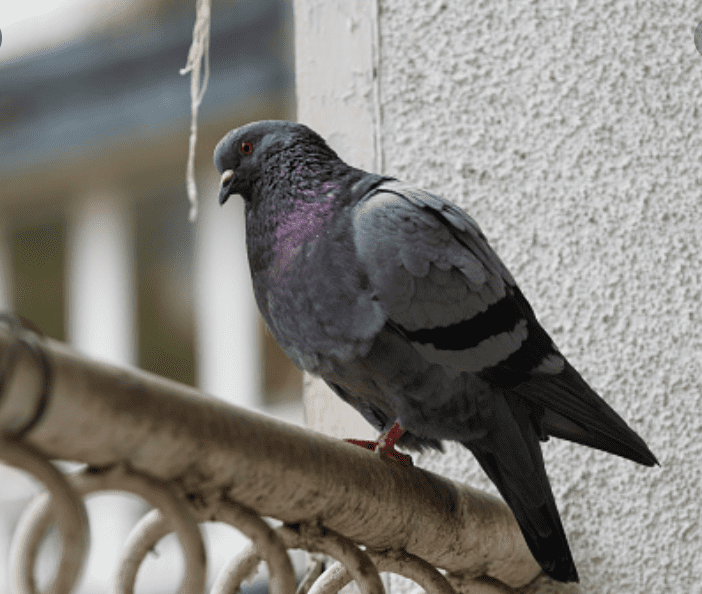
by Pigeon Patrol | Jun 14, 2023 | Bird Spike, Pigeon Droppings, Pigeon Patrol's Services, Pigeon Predators, Pigeon Spikes, Pigeons, Pigeons in the News
For half a century after WWII ended, the Swiss army refused to decommission its carrier pigeons, even though they had long outlived their usefulness.
Certain species of pigeons have an uncanny ability to find their way home to their coops from any distance. That is why pigeons were widely used to carry messages from one military unit to another in World War I and II.
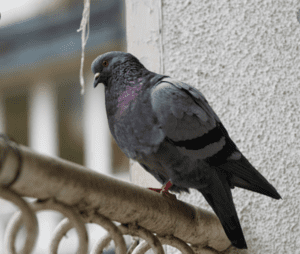
But only the Swiss army had kept its pigeons long after the war ended — until 1996. They have been on standby for decades in case of invasion— this time from the Soviet Union.
The birds “have been specially trained for homing and are used to flying long distances over all kinds of terrain,” Samuel Iselin, a spokesman for the Federal Office of Signal Troops in Bern, said just before the pigeon troops were disbanded.
But since the country had not been involved in either of the world wars, it is safe to assume that Swiss pigeons had never seen active combat duty or witnessed any frontline action.
There is also no record of any of them falling victim to enemy fire, unlike their French counterpart, Cher Ami, which was hit while delivering messages during the Battle of Verdun in 1916. She was awarded the posthumous Croix de Guerre medal for her bravery.
It is perhaps natural to think that pigeons carried messages in their beaks, like the olive branches. But in fact, messages were written on light paper, rolled into a small tube, and attached to the bird’s leg.
From 1919 until 1996, Switzerland owned 7,000 pigeons; another 23,000 were on standby to use in case of national emergency.
In the early 1990s, the Defense Ministry decided to save $476,000 a year by finally retiring the flock and focusing on more modern communication methods.
But in a truly Swiss fashion, a pro-pigeon group had collected 100,000 signatures for a referendum to enshrine the carrier pigeon service in the Swiss constitution.
In the end, however, bird enthusiasts and the army reached a compromise: a new foundation was established especially to care for the retired military pigeons in their new civilian life.
Thirty elite birds were pigeonholed, as it were, to live out their retirement in warmer climes.
They were sold to a private South African buyer, and they didn’t even have to fly to their new home themselves. “The pigeons were handed over in Zurich and put aboard a South African Airways flight,” Iselin explained.
Source
Pigeon Patrol Products & Services is the leading manufacturer and distributor or bird deterrent (control) products in Canada. Pigeon Patrol products have solved pest bird problems in industrial, commercial, and residential settings since 2000, by using safe and humane bird
deterrents with only bird and animal friendly solutions. At Pigeon Patrol, we manufacture and offer a variety of bird deterrents, ranging from Ultra-flex Bird Spikes with UV protection, Bird Netting, 4-S Bird Gel and the best Ultrasonic and audible sound devices on the market today.
Voted Best Canadian wholesaler for Bird Deterrent products ten years in a row.
Contact us at 1 877-4-NO-BIRD,(604) 585-9279 or visit our website at www.pigeonpatrol.ca
Pigeon/Pigeon Patrol / Pigeons Roosing / Vancouver Pigeon Control / Bird Spikes / Bird Control / Bird Deterrent / PIgeon Deterrent / Surrey Pigeon Control / Pest / Seagull deterrent / Vancouver Pigeon Blog / Birds Inside Home / Pigeons in the cities / Ice Pigeons / What to do about pigeons / sparrows, Damage by Sparrows, How to Keep Raccoons Away, Why Are Raccoons Considered Pests / De-fence / Pigeon Nesting / Bird Droppings / Pigeon Dropping / woodpecker control / Professional Bird Control Company / Keep The Birds Away / Birds/rats/seagull/pigeon/woodpecker/dove/sparrow/pidgeon control/pidgeon problem/pidgeon control/flying rats/pigeon problems/ bird netting/bird gel/bird spray/bird nails/bird guard











